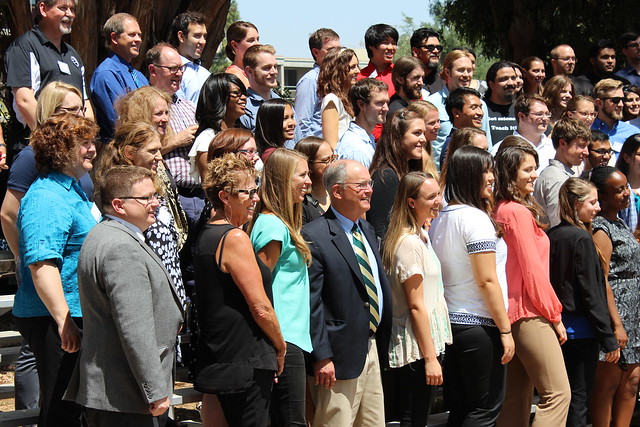Cal Poly Students Dive into Research with STAR Program
End of summer conference puts students’ work on display for mentors, peers
In a bustling conference room on a scorching August afternoon, Cal Poly biological sciences graduate student Katharyn O’Grady explained variations in size frequency between mainland and island populations of Kellet's whelk to a crowd of scholars, educators and peers.

STAR Program fellow Katie O'Grady interacts with a researcher
during the program's closing conference Aug. 15, 2015.
Standing in front of a poster board covered in graphs and charts, she described harvesting strategies that might create a more sustainable ecosystem for the commercially fished gastropods.
For her, and nearly 70 other aspiring and early-career high school and middle school teachers, the day signaled the end of a summer spent immersed in research at a laboratory.
The current and future teachers were part of the STEM (science, technology, engineering, and math) Teacher and Researcher (STAR) Fellowship program, which pairs the fellows with top scientists at national and university laboratories along the west coast. The fellows work on real-world research projects for nine weeks with the expectation that they will bring their experiences back to the classroom.
“When you're a teacher, you're going to have to realize that you're not a purveyor of information,” said Phil Bailey, dean of the College of Science & Mathematics, in an address to the fellows. “You're not teaching chemistry. You're not teaching mathematics. You’re teaching people how to learn chemistry. You're teaching people how to learn mathematics. That's a big difference; it's an important difference.”

STAR Program fellow Deborah Kim explains her research findings
during the program's end of summer conference Aug. 15, 2015.
Katelynn Lee, a junior majoring in biological sciences, was paired with mentor Gabriela Loots at Lawrence Livermore National Laboratory. She examined the role signaling pathways play in bone development and repair. The results of her research, titled “Characterization of putative Wnt3a-Inducible Enhancers,” might one day help scientists develop nonsurgical treatments for weak or broken bones.
“I think it brings the real world into the classroom,” Lee said of the program. “So if one of my students is interested in research, I can have that experience to share with them.”
The program helps prepare and retain teachers in STEM fields and is an invaluable experience for the fellows.
“I think the fellows have seen the great benefit in their STAR experience — in just immersing themselves in active learning research experiments,” Bailey said. “That's a tremendous, hands-on, learn by doing experience. That's what the STAR program is about.”
The program is administered by Cal Poly’s Center for Excellence in STEM Education (CESAME) and is open to students throughout the California State University system. It’s funded by grants from the National Science Foundation, the Chevron Corporation, the National Marine Sanctuary Foundation, the S.D. Bechtel, Jr. Foundation and the Howard Hughes Medical Institute.
Photo Gallery: 2015 STAR Closing Conference





